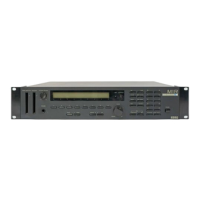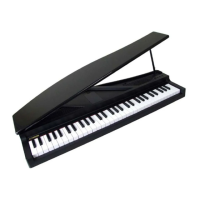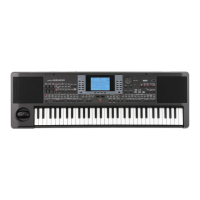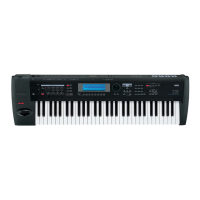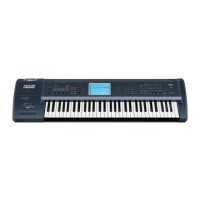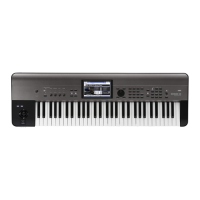Front and rear panels Objects in the display
17
Quick Start
Introduction
SetupProgram
Combination
Sequencer
SamplingGlobalMediaEffectKARMA
Drum Track
Other
Appendices
10. Fastening screws
These are screws (knurling screws M3×8) that fasten
the M3-M to the keyboard assembly. For details, please
see “Keyboard assembly Manual.”
Bottom panel
11. TO KYBD connector
Use the included cable to connect the M3 to the
keyboard assembly. For details, please see “Keyboard
assembly Manual.”
12. EXB option cover
You’ll need to open or close this cover when installing
the EXB-RADIAS, EXB-FW, or EXB-M256 separately
sold options into the M3, or when replacing the
calendar backup battery.
For details on installing, please see page 202.
Objects in the display
The M3 uses Korg’s TouchView graphical user
interface.
By touching on objects shown on the display, you can
select pages, set parameter values, rename programs
and combinations, write data, and perform many other
operations.
If the X–Y MODE switch is on, you won’t be able
to select parameters in the display. Turn this
switch off when you want to modify the settings.
Note: References in the M3’s manual to the “... button”
or “... tab” please see objects shown on the display.
References to the “... switch,” “... knob,” “... dial,” or
“... slider” please see controls on the front or rear panel
of the M3.
a: Current page
This indicates the current page within the selected
mode.
From the left, this area shows the mode name, page
number: name, and tab name.
b: Tab
Most pages are divided into two or more tabs.
c: Parameters
The parameters for various settings are displayed in
the display.
d: Edit cell
When you touch a parameter on the display, the
parameter or parameter value will usually be
highlighted (displayed in inverse video). This is called
the edit cell, and the highlighted item will be subject to
editing.
For details on how to edit the value, please see “3.
Selecting a parameter and editing the value” on
page 23.
a: Current page
f: Popup button (1)
g: Popup button (2)
e: Check box
h: Menu command
b: Tabd: Edit cell c: Parameter
Tab name
Mode name Page number
